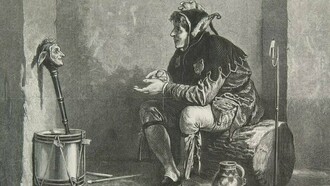Crime and culture are often viewed as opposing forces—one representing society's failures, the other its achievements. But what happens when criminal organizations don't simply reject cultural values but instead amplify and distort them? Japan's yakuza offer a fascinating lens through which to examine how cultural traditions can paradoxically flourish even within society's shadows.
Today, the yakuza are in steep decline. Membership has dropped to historic lows, and Japan’s largest syndicate, the Yamaguchi-gumi, recently declared an end to a decade-long internal feud amid mounting police pressure and public rejection. Yet their cultural legacy lingers, etched in ink, ritual, and paradox.
The outcasts who embody tradition
The yakuza—whose name derives from the worst possible hand in a traditional Japanese card game (ya-ku-sa: 8-9-3)—represent one of the world's most culturally embedded criminal organizations. Far from being mere thugs, these syndicates have developed elaborate cultural practices that mirror and magnify aspects of mainstream Japanese society.
Their modern form emerged in post-war Japan, when collapsed institutions left citizens scrambling for food, shelter, and order. The yakuza filled that void, controlling black markets, distributing supplies, and enforcing their brand of stability. devastation. But rather than operating as simple criminal enterprises, they evolved into something uniquely Japanese: crime syndicates bound by ritual, hierarchy, and cultural symbolism.
Living art and painful loyalty
Nowhere is the yakuza's cultural imprint more visible than their full-body tattoos—irezumi—which depict dragons, koi, and mythological heroes drawn from Japanese folklore. These aren't just decorations; they’re visual biographies, worn like armor. The tattooing process, often done by hand (tebori), takes years and demands extraordinary pain tolerance, transforming endurance into a rite of passage.
Equally striking is the practice of yubitsume—the ritual amputation of finger joints as punishment or atonement. Though this practice has declined due to legal restrictions and social reintegration challenges, it once embodied Japan’s deep-rooted values of accountability and honor. Today, many syndicates have replaced physical punishment with financial penalties or expulsion, reflecting a shift toward discretion and survival in a society that increasingly rejects them.
The family business of crime
Japanese society places enormous emphasis on group loyalty, hierarchy, and family bonds. The yakuza have constructed elaborate pseudo-family structures that mirror these values. Members refer to each other using family terms—oyabun (father), kobun (children), and kyodai (brother)—creating networks of mutual obligation that parallel Japan's corporate and social hierarchies.
These aren't merely organizational structures but genuine sources of identity and belonging for members who often come from broken families or marginalized communities. For many, the yakuza provides what mainstream society has denied them: acceptance, purpose, and a clear place in a structured world.
Outcasts by design
Most yakuza members come from Japan's marginalized populations: ethnic Koreans, the historically discriminated Burakumin class, and young men from troubled backgrounds. In a society that values conformity and belonging, these individuals found themselves permanently excluded from conventional paths to success.
The yakuza’s response was not to reject Japanese culture but to intensify it. Their rituals, hierarchies, and codes of honor weren’t foreign to Japan; they were Japan, taken to its most rigid and visible extremes.
The cultural paradox
This creates a fascinating paradox: the yakuza are simultaneously Japan's most devoted cultural practitioners and its most obvious cultural outcasts. They embody traditional Japanese values—loyalty, honor, group solidarity, and respect for hierarchy—while being completely rejected by the society that holds these same values.
Today, signs reading "No Yakuza" hang in businesses across Japan. Former members struggle to find legitimate employment, their tattoos and criminal records marking them as permanently other. Yet their exclusion only reinforces their cultural distinctiveness, creating a shadow society that mirrors the mainstream while remaining forever separate from it.
Lessons in cultural complexity
The yakuza challenge simple narratives about crime and culture. They show how tradition can be preserved, distorted, and reimagined, even in the underworld. Their elaborate traditions, codes of conduct, and social structures reveal the complex ways that cultural identity persists even among society's outcasts.
In 2025, the yakuza may be fading, but their legacy remains. Not as romanticized antiheroes, but as a mirror reflecting the contradictions of a culture that both reveres and rejects its own values.
The yakuza challenge simple narratives about crime and culture. They show how tradition can be preserved, distorted, and reimagined, even in the underworld. Their elaborate traditions, codes of conduct, and social structures reveal the complex ways that cultural identity persists even among society's outcasts.
In 2025, the yakuza may be fading, but their legacy remains. Not as romanticized antiheroes, but as a mirror reflecting the contradictions of a culture that both reveres and rejects its own values.
Their decline also poses a new question: what happens to cultural practices when their host institutions dissolve? As former members attempt to reintegrate into society, some elements—tattooing, ritual language, and loyalty codes—quietly filter into mainstream subcultures, from fashion to film. In this way, the cultural residue of the yakuza continues to permeate Japanese society, even as the organizations themselves vanish. Far from disappearing entirely, their symbols and structures persist in altered forms, reminding us that culture is rarely erased—it transforms, often in unexpected places.
References
Hill, P. (2014). Chapter 11: The Japanese yakuza. In L. Paoli (Ed.), The Oxford Handbook of Organized Crime (pp. 234–253). Oxford University Press.
Kaplan, D.E., Dubro, A., (2012) Yakuza: Japan’s criminal underworld. Berkeley: University of California Press
Kersten, J., 1993. Street youths, bosozoku, and Yakuza: Subculture formation and societal reactions in Japan. Crime & Delinquency, 39(3), pp.277-295.
Raz, Jacob (2002) ‘Self-Presentation and performance in the yakuza way of life: Fieldwork with a Japanese underworld group’ In R. Goodman and K. Refsing (eds.) Ideology and Practice in Modern Japan. London: Routledge.
Yamada, M., 2009. Westernization and cultural resistance in tattooing practices in contemporary Japan. International journal of cultural studies, 12(4), pp.319-338.














